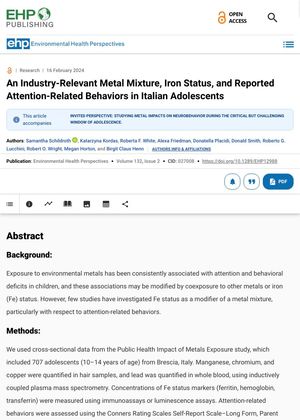An Industry-Relevant Metal Mixture, Iron Status, and Reported Attention-Related Behaviors in Italian Adolescents
February 2024
in “
Environmental health perspectives
”

TLDR Exposure to certain metals may worsen attention-related behaviors in adolescents, with stronger effects in females.
The study involved 707 Italian adolescents aged 10-14 years and investigated the relationship between exposure to a mixture of metals (manganese, lead, chromium, copper) and attention-related behaviors. Higher concentrations of these metals, particularly manganese, were associated with worse self-reported outcomes for attention deficit/hyperactivity disorder (ADHD) index, inattention, and hyperactivity. The study found no evidence that iron status, indicated by ferritin levels, modified these associations. A secondary analysis also showed a modest association between increasing blood lead concentrations and higher scores for self-reported hyperactivity. The joint association of the metal mixture with self-reported outcomes was stronger in females, primarily driven by manganese. The study suggests that exposure to metal mixtures in adolescence may negatively impact attention-related behavior.